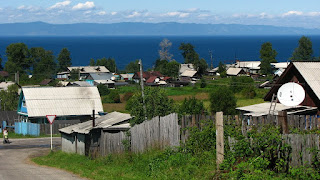Lake Baikal is a special place indeed. It is not just the deepest lake in the world, but also the oldest one with the biggest volume of water. Its depth is more than 1600 m. It contains almost 20% of all unfrozen fresh water of the planet, which is more than all the 5 Great Lakes of North America together. And the water is still potable! The length of the lake is around 650 km (pretty much size of the Vancouver Island). It fully freezes in winter and is used as a highway as well.
The vastness of the Lake Baikal, one can't see the other side.
"Maloe More" (Little Sea), one of the 2 warmest parts of the lake. Generally water of Baikal is cold all year long.
The northern cliffs of the magical Olkhon Island.
Evening fishing on the calm Lake Baikal. It is not always that calm and you can easily feel like by the sea.
It's not just the lake's beautiful islands and peninsulas that make this area so special, but also the mountain ranges and pristine forests. Here are some of the places that impressed me.
Easter Sayan Mountains in Tunka Valley and the very popular spa spot Arshan. By the Mongolian border are these mountains over 3,400 m high.
Tunka valley is a beautiful place in Buryatia, which leads directly to the Mongolian border. There are hot springs in the valley, unfortunately not natural anymore. The valley lies between Khammar-Dhaban Mountains and Easter Sayans Mountains.
Holy Nose Peninsula is part of the Zabaikalsky Nature Reserve with high mountains rising over 1400 m right from the water surface. Close by are the Ushkhany Islands, a very popular spot for "nerpas" - Baikal endemic freshwater seal.
Barguzin valley and the Zabaikalsky National Park. Another still quite traditional valley, where one can see the Buryat culture.
Khammar-Dhaban mountains, a mountain range on the south-east of the Lake Baikal. The nature reserve, where I work belongs to this mountain range as well. The valley in the picture is called Mammai, very popular for free ride skiing in winter.
The dense forest of our Baikal Nature Reserve. Together with other 7 protected areas around Lake Baikal, it is certified as a World Heritage Site.
Another interesting aspect of this area is that 4 different religions meet here: the Christian based Russian Orthodox and Old Believers, in additional to, the Buryat's Shamanism and Buddhism. Buryat people are Mongolian descendents. The western Buryats in Irkutsk Region are more into shamanism and the easter from Buryat Republic are buddhists.
Buryats have a tradition to leave a strip of cloth on places, where they want to return one day.
Buryat traditional clothes. They used to be nomads and lived in yurts. Later on, when they settled down on one place they change their yurt into a wooden one.






























